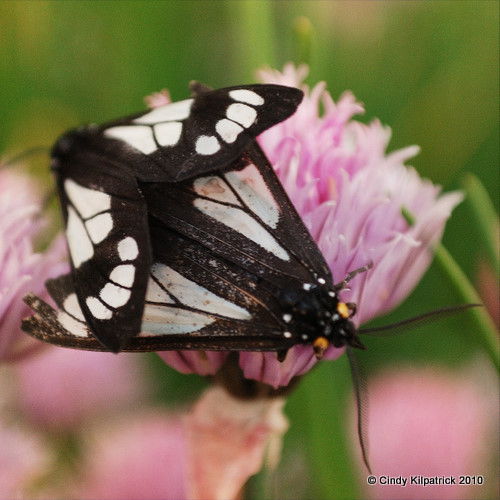Police Car Moth
Gnophaelia vermiculata
This moth’s genus is fairly easy to remember if you can remember its common name, which shouldn’t be hard as it looks so much like an old-time police car with its bold black and white colouring and brilliant orange ‘lights’ at the top of its thorax. If I’m not mistaken (and the pronunciation of latin names seems to vary), ‘Gnophaela‘ looks to sound like ‘No Fail Ya’ and that puts me in mind of the Canadian Mounties who ‘Always Get their Man’. 🙂 ‘Vermiculata‘ means ‘worm-like’ – I would think that would apply to most caterpillars.

I think I have finally figured out why the wild Lungwort in my gardens look so sad after the blooms have finished in August. It is the favourite food of the Police Car Moth's larva.
It can be hard though, to remember that this is a moth, not a butterfly. As this Everyday Mysteries site tells us, “One of the easiest ways to tell the difference between a butterfly and a moth is to look at the antennae. A butterfly’s antennae are club-shaped with a long shaft and a bulb at the end. A moth’s antennae are feathery or saw-edged.”

Everything is busy reproducing in my gardens in July. These two have found a wonderfully scented nest of 'Mrs. Simpson's Pinks' carnations.
You can’t really see it here, but this insect has quite a thick body. Butterflies tend to be much more svelte. Otherwise, this moth breaks a lot of rules. For one, it is diurnal – it flies during the day unlike the majority of moths – but also it’s really beautiful! Not dull coloured as so many moths are.

It looks like the male has seen better days, but his mate seems to be keeping him company as he catches his breath.
If you look closely, (no it’s not rude – it’s nature!), you can see that the antennae are quite feather-like and have no bulb at the end. You can tell a male moth from a female by the width of its antennae: the male is the one with the larger ‘feathers’ (antennae).
As Weaslehead.org reports, Police Car Moths are “Notoriously poor flyers… tend to stick close to the ground and are easily observed and photographed. They are also relatively harmless and do little if any damage to the plants they feed on.” So there you go. That’s why I managed to get such clear shots of them this summer. 🙂
It was fascinating to watch this delicate critter gracefully and methodically building its cocoon. Unfortunately it was very bad timing to repair the eaves trough and it didn’t survive. Here is a much better photo I found of the Police Car Moth caterpillar.



